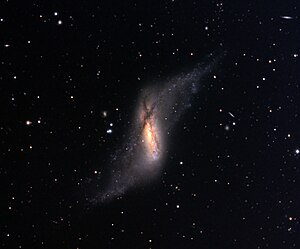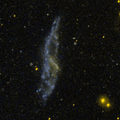NGC 660
| Galaxy NGC 660 |
|
|---|---|

|
|
| Amateur recording | |
| AladinLite | |
| Constellation | fishes |
|
Position equinox : J2000.0 , epoch : J2000.0 |
|
| Right ascension | 01 h 43 m 02.4 s |
| declination | + 13 ° 38 ′ 42 ″ |
| Appearance | |
| Morphological type | SB (s) a pec; HII LINER |
| Brightness (visual) | 10.7 mag |
| Brightness (B-band) | 11.7 mag |
| Angular expansion | 8.3 ′ × 3.2 ′ |
| Position angle | 170 ° |
| Surface brightness | 14.1 mag / arcmin² |
| Physical data | |
| Affiliation | M74 group |
| Redshift | 0.002835 ± 0.000003 |
| Radial velocity | 850 ± 1 km / s |
|
Stroke distance v rad / H 0 |
(42 ± 3) x 10 6 ly (12.8 ± 0.9) Mpc |
| history | |
| discovery | Wilhelm Herschel |
| Discovery date | October 16, 1784 |
| Catalog names | |
| NGC 660 • UGC 1201 • PGC 6318 • CGCG 437-012 • MCG + 2-05-13 • IRAS 01403 + 1323 • GC 390 • H II-253 • PRC C-13 | |
NGC 660 is a barred spiral galaxy in the constellation Pisces , approximately 42 million light years from the Milky Way . NGC 660 is one of the few polar ring galaxies . It was discovered on October 16, 1784 by the German-British astronomer Wilhelm Herschel .
In 2012, observations with radio telescopes showed a sudden increase in activity. More recent high-resolution observations show a new, extremely bright radio source within NGC 660. A possible interpretation is a growing supermassive black hole, presumably with a mass of 20 million suns. For the first time it can now be observed how an extremely massive black hole develops its activity.
Photo from the Hubble Space Telescope
Recording of the ultraviolet emission using GALEX
Web links
Commons : NGC 660 - collection of images, videos, and audio files
- Rare Polar-Ring Galaxy Captured in New Image , NGC 660, recorded with the 8 m Gemini telescope
- NOAO
- NGC 660 is a rather peculiar galaxy
- Compact Radio Sources in NGC 660
- Polar Ring Galaxy NGC 660 - Astronomy Picture of the Day from January 22, 2011.
- SIMBAD Astronomical Database


